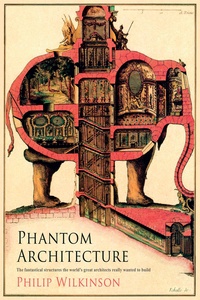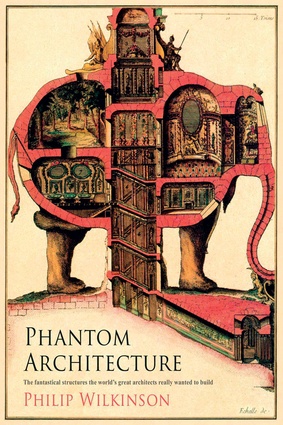Books: Phantom Architecture
Guy Marriage reviews Phantom Architecture by Philip Wilkinson.
Phantom Architecture – no, it’s not about The Ghost That Walks but it is a surprisingly good read anyway, with a wealth of information about the topic we all love to talk about – the ‘One That Got Away!’

Author Philip Wilkinson has turned years of historical research into the back stories of a hundred or so buildings that never were. It is the sort of book which would be perfect for the budding architectural student in your life – if you can tear them away from Facebook and ArchDaily – as this is far more enjoyable than a web page.
There are classic stories that we all know about, like Adolf Loos and the Chicago Tribune tower, and more recent ones, like Zaha Hadid’s Peak scheme in Hong Kong, but the book encompasses far more obscure schemes like the giant elephant on the front cover – from an architect I’m fairly sure you’ve never heard of: Charles-François Ribart de Chamoust. As far as elephant statues go, this was a biggie: apparently with enough room in its body for a ballroom, complete with a small orchestra. File that one in the list of ‘unlikely to proceed’ jobs; even the (late) King of France couldn’t afford it.
Things do become easier and more familiar. There are Archigram’s Walking City (of course) and Kenzo Tange’s Tokyo Bay project (naturally), as well as Frank Lloyd Wright’s Mile-High skyscraper (still as inspiring as ever). Wilkinson writes in an easy-to-grasp style so it is a book for young or old, no matter how much you know, but he certainly has done the hard yards of research.
I thought I was reasonably well read but I’d never heard of Hermann Finsterlin (mit ein wild & verrückt Traum auf Glas) and nor did I realise that Antonio Sant’Elia didn’t start his office until 1912 but was dead by 1916: lost in a battle in WWI. That means the prolific and visionary futurism that Sant’Elia created – which still looks so modern and futuristic today – is even more amazing than I had realised. What a vision to leave with the world!
There are, of course, no Kiwi architects’ unrealised visions in this volume, despite us all, no doubt, having an extensive back catalogue of unrequited dreams. We’re clearly still not dreaming big enough yet. What is good, however, is the realisation that everyone, even the really famous and the really talented (those two phrases do not always belong together) has their projects that don’t proceed.
The difference between madness and unbounded creativity is a very thin line – while Le Corbusier is listed in here with the Ville Radieuse as an unbuilt masterpiece (thank goodness it never happened in real life, I say!), that just makes Ronchamp even more amazing for having been built at all.
Pier Luigi Nervi’s church design for the Benedictine order in Perth, Australia, is clearly a loss for never having been completed (apparently, there are sets of stained-glass windows hidden away, ready for this Nervi building that will never be completed).
Arata Isozaki’s proposed giant trees (with apartments for leaves), Clusters in the Air, was a proposal like the capsule hotel towers on steroids, intended to help solve the crowding issues in Tokyo. They would have been amazing had they been built – we can see glimpses, perhaps, in the latest Blade Runner 2049 movie.
Peter Eisenman’s proposed megastructure Nearly Fifty Miles Long, with Michael Graves, was a lucky escape from monstrous and monotonous banality – I mean, really, who needs a building that big, ever? Was it ever a really serious proposal? Or was it, like Buckminster Fuller’s proposed Dome over Manhattan (at two miles wide), more of a position statement than a considered folly, doomed to remain forever glowing in the books of architectural history as an also-ran?
What this book does is allow you to dream or, at least, sketch out those dreams, no matter how crazy. It’s perfect holiday reading while you relax in the recliner at the beach – and dream of giant pink elephants and fistfuls of NZIA Awards for cleverness and inventiveness. You’ll wake up eventually but by then it will be January and you’ll wonder: was it all just a dream?











